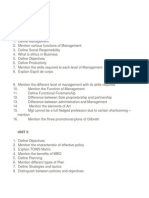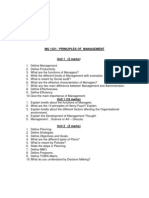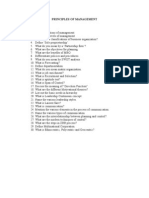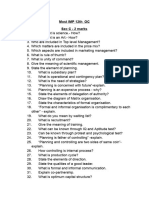Hut310 Imp
Hut310 Imp
Uploaded by
Zeus SathanCopyright:
Available Formats
Hut310 Imp
Hut310 Imp
Uploaded by
Zeus SathanCopyright
Available Formats
Share this document
Did you find this document useful?
Is this content inappropriate?
Copyright:
Available Formats
Hut310 Imp
Hut310 Imp
Uploaded by
Zeus SathanCopyright:
Available Formats
Module 1
1. Give a brief account of the significance of the systems approach to the study of management. Discuss
the advantages and Limitations of system approach.
2. List four important interpersonal skills to be possessed by a manager.
3. Explain the various levels of management.
4. Discuss the nature and scope of management.
5. Describe the skills of a good manager.
6. Define and describe the nature and goals of management.
7. What are the functions of manager in your opinion? Explain.
8. Enumerate the various roles performed by managers as a part of their profession.
9. Distinguish between administration and management.
10. Is management a science or an art? Substantiate your response.
11. Define management.
12. Why management is called an art and science?
13. List and elaborate five important roles of a manager.
Module 2
Module-II
1. Define span of control. List the factors affecting it.
2. Define organizational structure.
3. Explain a) Functional organization b) Matrix organization c) Committee organization. Discuss the
merits demerits of each one.
4. Classify the factors affecting the span of control.
5. Distinguish between line and staff functions with the aid of examples.
6. What is an organization chart? What are its merits and demerits?
7. How does a leader differ from a manager?
Downloaded from Ktunotes.in
8. Explain trait approach to leadership and contingency approach.
9. Critically evaluate the trait approach with an example.
10. Explain the process of controlling function with the aid of a sketch.
11. Write a short note on strategic planning. What is the difference between vision and mission? Give an
example.
12. Explain different steps in planning.
13. What do you mean by top-down policy and bottom-up planning and execution approach
Module 3
Module-III
1. Why decision making is a difficult task. List any two methods to deal with decision making under
uncertainty.
2. Illustrate the difference between programmed and non-programmed decisions by highlighting
suitable examples.
3. What is productivity ? Mention the types of productivity.
4. Discuss the factors influencing productivity.
5. What are the steps involved in decision tree analysis. For what types of projects decision tree is
useful.
6. What do you mean by a risky situation in business? How is decision taken under risk? Business always
operate in an environment of uncertainty'. Do you agree? Give 3 reasons.
7. What are the factors affecting productivity?
8. Distinguish between production and productivity.
Problems
1. Productivity
2. Decision tree analysis
Module 4
Downloaded from Ktunotes.in
1. Explain the concept and objectives of network analysis. What are its different stages? Discuss its
advantages and limitations.
2. Explain PERT and its importance in network analysis?
3. Define organizing and explain the importance of organizing in the present business environment.
4. Explain the concepts of crashing and dummy activity in project management.
5. Differentiate between CPM and PERT.
Problems
1. CPM
2. PERT
3. Project Crashing
Module 5
Module-V
1. Describe any one instance of application of Corporate Social Responsibility.
2. Clearly explain the functions of financial management? Describe the challenges faced by a finance
manager.
3. What are the purposes of budget?
4. Classify the various budgets and compare them.
Downloaded from Ktunotes.in
5. Write a note on staffing function of management.
6. Distinguish the following: Recruitment, Selection, Placement and Induction. 11. List the advantages
and limitations of interview as a selection technique.
7. What are the requirements of the staff of the firm in order to call it as a culture responsive firm?
8. How entrepreneurs differ from workers.
9. What are the objectives of operations management ?
10. Distinguish between the following: (a) Assets and Liabilities (b) Production concept and Marketing
concept (c) Needs and Wants (d) Design functions and Operational control functions in operations
Downloaded from Ktunotes.in
You might also like
- Project Charter TemplateDocument6 pagesProject Charter TemplateRasika DilshanNo ratings yet
- MG 1351 - Principles of Management 20 Essay Questions andDocument15 pagesMG 1351 - Principles of Management 20 Essay Questions andsaranjsp93% (111)
- Project Management Leadership: Building Creative TeamsFrom EverandProject Management Leadership: Building Creative TeamsRating: 4 out of 5 stars4/5 (1)
- Chapter 5 - The Project in The Organizational StructureDocument40 pagesChapter 5 - The Project in The Organizational StructureJeng AndradeNo ratings yet
- POM - B.com A&FDocument10 pagesPOM - B.com A&Falonejoker2k5No ratings yet
- Pom Question BankDocument8 pagesPom Question BankJeevaNo ratings yet
- Business StudiesDocument9 pagesBusiness StudiesAYu ROckNo ratings yet
- MG6851-Principles of Management Question BankDocument5 pagesMG6851-Principles of Management Question BankThirumal AzhaganNo ratings yet
- MG2351 QBDocument5 pagesMG2351 QBVishal ChandrasekharNo ratings yet
- Part A Unit 1Document6 pagesPart A Unit 1Jaya Raja SekarNo ratings yet
- Principles of ManagementDocument11 pagesPrinciples of Managementtharoon22032007No ratings yet
- EdpM Question BankDocument2 pagesEdpM Question BankNitin yadavNo ratings yet
- Mg8591 Principles of Management Reg 2017 Question BankDocument5 pagesMg8591 Principles of Management Reg 2017 Question BankYukeshNo ratings yet
- Principles of Management Question BankDocument5 pagesPrinciples of Management Question BankPrabhu Easwar100% (2)
- Pom - QBDocument6 pagesPom - QBkingsley_psbNo ratings yet
- Pom - QBDocument3 pagesPom - QBmohankumar948826No ratings yet
- BA7101-Principles of ManagementDocument5 pagesBA7101-Principles of ManagementJaiGaneshNo ratings yet
- Principles of Management Mg2351 Anna University Question BankDocument4 pagesPrinciples of Management Mg2351 Anna University Question BankjeebalaNo ratings yet
- ME Question BankDocument2 pagesME Question BankaaaaNo ratings yet
- MPP QuestionsDocument6 pagesMPP QuestionsniharaNo ratings yet
- MG6851 - PoM 2 & 16 MarksDocument4 pagesMG6851 - PoM 2 & 16 MarksmsksaranNo ratings yet
- Manag Ement & Entrepreneurship 10AL61: Assignment Q UestionDocument6 pagesManag Ement & Entrepreneurship 10AL61: Assignment Q UestionSuhasNo ratings yet
- IPMZ Higher Dip Assignment Booklet April 2013Document15 pagesIPMZ Higher Dip Assignment Booklet April 2013Ngoni MukukuNo ratings yet
- Unit - I Part-A (2 Marks)Document6 pagesUnit - I Part-A (2 Marks)dhirajsingh_avitNo ratings yet
- POM QTBNK PDFDocument7 pagesPOM QTBNK PDFjNo ratings yet
- QB PomDocument3 pagesQB PomPranav JadhavNo ratings yet
- WWW - Universityquestions.in: BA 7302 Strategic ManagementDocument5 pagesWWW - Universityquestions.in: BA 7302 Strategic ManagementshahulsuccessNo ratings yet
- Fom-Qb 1Document10 pagesFom-Qb 1Naughty DreamerNo ratings yet
- Question BankDocument5 pagesQuestion BankmuruganphdNo ratings yet
- Review QPDocument1 pageReview QPAbdul NazèêrNo ratings yet
- Question Bank MGC ODD Sem 2023Document2 pagesQuestion Bank MGC ODD Sem 2023deeksha6548gkNo ratings yet
- Unit-I Management Part A (2 Marks)Document4 pagesUnit-I Management Part A (2 Marks)Selvasundar KumarNo ratings yet
- Important Questions of M&EDocument2 pagesImportant Questions of M&Eprakasha shanbogNo ratings yet
- MBE Question BankDocument4 pagesMBE Question BankMonisha ReddyNo ratings yet
- M&E Question BankDocument7 pagesM&E Question BankArun NesamNo ratings yet
- Time Super-Imp-Tie-23 (1) (1) PDFDocument1 pageTime Super-Imp-Tie-23 (1) (1) PDFanspoorthyNo ratings yet
- MG 1351 - Principles of Management 20 Essay Questions and AnswersDocument15 pagesMG 1351 - Principles of Management 20 Essay Questions and AnswersAnthony RollinsNo ratings yet
- BA7302 Strategic ManagementDocument5 pagesBA7302 Strategic ManagementanthoniammalNo ratings yet
- Strategic Managementx MBA III 574479649 PDFDocument51 pagesStrategic Managementx MBA III 574479649 PDFNikita RanjanNo ratings yet
- Question Bank Mba Iii Sem FT 301C Strategic Management Unit's Name No. of QuestionsDocument51 pagesQuestion Bank Mba Iii Sem FT 301C Strategic Management Unit's Name No. of QuestionsTanmay SinhaNo ratings yet
- MG 1351 - Principles of Management 20 Essay Questions and AnswersDocument15 pagesMG 1351 - Principles of Management 20 Essay Questions and AnswersAnonymous uHT7dDNo ratings yet
- EE51 Super-Imp-Tie-23Document2 pagesEE51 Super-Imp-Tie-23Radhadevi tr Radhadevi trNo ratings yet
- VI - Civil.OE-II (Human Resource Development & Organizational Behaviour)Document4 pagesVI - Civil.OE-II (Human Resource Development & Organizational Behaviour)Vaibhav DewdheNo ratings yet
- CS1351 PomDocument3 pagesCS1351 PomsaravanasanuNo ratings yet
- BA 5302 Strategic Management: Department of Management Studies Unit-I Part-ADocument5 pagesBA 5302 Strategic Management: Department of Management Studies Unit-I Part-AHarihara Puthiran100% (1)
- Principles of Management: Two Marks Question and AnswersDocument21 pagesPrinciples of Management: Two Marks Question and AnswersVignesh ArasuNo ratings yet
- 18OA01 - Mod 1&2 QuestionsDocument1 page18OA01 - Mod 1&2 Questionssowmiyajothi563No ratings yet
- Business Studies 2nd PUC NotesDocument12 pagesBusiness Studies 2nd PUC Notessultanamubarak09No ratings yet
- SPM Question BankDocument5 pagesSPM Question BankAmit BadamNo ratings yet
- BA7053 Project ManagementDocument5 pagesBA7053 Project ManagementPradeepa p.mNo ratings yet
- Engineering Management and Ethics QB 2013Document7 pagesEngineering Management and Ethics QB 2013MATHANKUMAR.S100% (1)
- Principles of Management (2 MARKS)Document2 pagesPrinciples of Management (2 MARKS)hari_krishnan_27No ratings yet
- Unit Wise Important Questions Unit - I Introduction To ManagementDocument9 pagesUnit Wise Important Questions Unit - I Introduction To ManagementPrasanthi PrasuNo ratings yet
- OM Question BankDocument5 pagesOM Question BankViraja GuruNo ratings yet
- Question Bank (Bba-Ii) Human Resource Management (BB 202) Unit-IDocument4 pagesQuestion Bank (Bba-Ii) Human Resource Management (BB 202) Unit-IMohammed IrshadhNo ratings yet
- ENTP Previously Repeated QuestionsDocument5 pagesENTP Previously Repeated QuestionsMOHAMMED SAAD AHMED 160418735109No ratings yet
- Most IMP OCDocument4 pagesMost IMP OCrakhi9374988660No ratings yet
- 21CB1503 Fundamentals of ManagementDocument11 pages21CB1503 Fundamentals of ManagementVaralakshmi KCNo ratings yet
- POM-PARTB Sem QuestionsDocument2 pagesPOM-PARTB Sem QuestionssakeshanpNo ratings yet
- Principle of Business Management (4 Year Question)Document2 pagesPrinciple of Business Management (4 Year Question)Rashmi Ranjan Panigrahi100% (1)
- Performance Management: Putting Research into ActionFrom EverandPerformance Management: Putting Research into ActionRating: 5 out of 5 stars5/5 (1)
- Final Sales Case Study - Avaya (A)Document8 pagesFinal Sales Case Study - Avaya (A)Karla Yvette CamachoNo ratings yet
- ANA Digital Marketing BPG PDFDocument48 pagesANA Digital Marketing BPG PDFDemand Metric100% (1)
- China Telecom Case StudyDocument3 pagesChina Telecom Case Studyinvincibleboy20005553No ratings yet
- LEI Daily Management To Execute Strategy Forward Intro Part 1Document33 pagesLEI Daily Management To Execute Strategy Forward Intro Part 1AndiewiccaNo ratings yet
- Joint Venture Worked Example Question 4 - Separate Books of AccountsDocument4 pagesJoint Venture Worked Example Question 4 - Separate Books of AccountsRoshan RamkhalawonNo ratings yet
- Decision Making StrategyDocument21 pagesDecision Making StrategyabafiabafuNo ratings yet
- Internal Academic Calendar Even Semester A.Y 23-24Document1 pageInternal Academic Calendar Even Semester A.Y 23-24joshituhina9No ratings yet
- EntrepDocument22 pagesEntrepNorilyn Cacho100% (1)
- Risk Assessment ChecklistDocument66 pagesRisk Assessment ChecklistassurendranNo ratings yet
- Enterprenuership Innovation Ver-2Document8 pagesEnterprenuership Innovation Ver-2DIVYANSHU SHEKHARNo ratings yet
- Chapter 28 Product Cost ControllingDocument52 pagesChapter 28 Product Cost Controllingzachary kehoeNo ratings yet
- Procedure For Management Review PDFDocument5 pagesProcedure For Management Review PDFSelvaraj Simiyon75% (4)
- Implementation (Action Plan)Document3 pagesImplementation (Action Plan)PeniNo ratings yet
- Name Prajwal Ghale Semester Third Roll No. NP000477Document2 pagesName Prajwal Ghale Semester Third Roll No. NP000477Prajwal GhalezNo ratings yet
- Business Model Template 08Document1 pageBusiness Model Template 08yolanda argi utamiNo ratings yet
- Assignment #1 IT in Quality Management System: Submitted byDocument3 pagesAssignment #1 IT in Quality Management System: Submitted bySyed Haider Ali BukhariNo ratings yet
- Value & Pricing Solutions in FMCGDocument21 pagesValue & Pricing Solutions in FMCGvikasnowalNo ratings yet
- TOTAL QUALITY MANAGEMENT PrelimDocument37 pagesTOTAL QUALITY MANAGEMENT PrelimRenier Palma CruzNo ratings yet
- L01 - Introduction To CBAP CertificationDocument18 pagesL01 - Introduction To CBAP CertificationRitesh SrivastavaNo ratings yet
- Data Governance Roles Explained - Data Owner, Steward & Custodian - AnmutDocument9 pagesData Governance Roles Explained - Data Owner, Steward & Custodian - AnmutGabrielGarciaOrjuelaNo ratings yet
- Carter Andrade ResumeDocument1 pageCarter Andrade ResumeVikas BawaNo ratings yet
- PM MethodologyDocument45 pagesPM MethodologyBahjat LadadwehNo ratings yet
- 2 Strategic Role of Operations ManagementDocument13 pages2 Strategic Role of Operations Managementseling97No ratings yet
- Pepsi FinalDocument77 pagesPepsi Finalizharulhaq1987No ratings yet
- Amazon Europe DistributionDocument6 pagesAmazon Europe DistributionShambhavi KumarNo ratings yet
- Joint Statement On IACS Members Commitment To Quality: A Guiding PrincipleDocument2 pagesJoint Statement On IACS Members Commitment To Quality: A Guiding PrincipleMugil RajanNo ratings yet
- Advantages of The Contribution ApproachDocument1 pageAdvantages of The Contribution Approachravi20288No ratings yet
- Research Analyst - ResearchDocument2 pagesResearch Analyst - ResearchSumit Kumar GuptaNo ratings yet

























































































